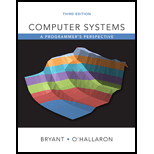
Computer Systems: A Programmer's Perspective (3rd Edition)
3rd Edition
ISBN: 9780134092669
Author: Bryant, Randal E. Bryant, David R. O'Hallaron, David R., Randal E.; O'Hallaron, Bryant/O'hallaron
Publisher: PEARSON
expand_more
expand_more
format_list_bulleted
Question
Chapter 12, Problem 12.29HW
Program Plan Intro
Deadlocks:
- The deadlock denotes a situation where a collection of threads remains blocked.
- It denotes waiting for a condition that will never be true.
- The progress graph denotes invaluable tool for understanding deadlock.
- If “P” and “V” operations are been ordered incorrectly, the forbidden regions for two semaphores would overlap.
- If some execution trajectory reaches deadlock state “d” then no further progress is possible.
- In this case each thread waits for the other one for a “V” operation that never occurs.
- The overlapping forbidden regions would induce a set of states called “deadlock region”.
- The deadlock is inevitable is trajectory touches a state in deadlock region.
- Once it enters deadlock regions, the trajectories could never leave.
Mutex lock ordering rule:
- A program is deadlock-free if each thread acquires its mutexes in order.
- It releases them in reverse order and given a total ordering for all mutexes.
- The mutex should be achieved in order to ensure deadlock free scheme.
Expert Solution & Answer
Want to see the full answer?
Check out a sample textbook solution
Students have asked these similar questions
I need help to solve the following case, thank you
hi I would like to get help to resolve the following case
Could you help me to know features of the following concepts:
- defragmenting.
- dynamic disk.
- hardware RAID
Chapter 12 Solutions
Computer Systems: A Programmer's Perspective (3rd Edition)
Ch. 12.1 - Prob. 12.1PPCh. 12.1 - Prob. 12.2PPCh. 12.2 - Practice Problem 12.3 (solution page 1036) In...Ch. 12.2 - Practice Problem 12.4 (solution page 1036) In the...Ch. 12.4 - Prob. 12.5PPCh. 12.4 - Prob. 12.6PPCh. 12.5 - Prob. 12.7PPCh. 12.5 - Prob. 12.8PPCh. 12.5 - Prob. 12.9PPCh. 12.5 - Prob. 12.10PP
Ch. 12.6 - Prob. 12.11PPCh. 12.7 - Prob. 12.12PPCh. 12.7 - Prob. 12.13PPCh. 12.7 - Prob. 12.14PPCh. 12.7 - Prob. 12.15PPCh. 12 - Prob. 12.20HWCh. 12 - Derive a solution to the second readers-writers...Ch. 12 - Prob. 12.22HWCh. 12 - Prob. 12.23HWCh. 12 - Prob. 12.24HWCh. 12 - Prob. 12.25HWCh. 12 - Prob. 12.26HWCh. 12 - Some network programming texts suggest the...Ch. 12 - Prob. 12.28HWCh. 12 - Prob. 12.29HWCh. 12 - Prob. 12.30HWCh. 12 - Implement a version of the standard I/O fgets...Ch. 12 - Prob. 12.32HWCh. 12 - Prob. 12.33HWCh. 12 - Prob. 12.34HWCh. 12 - Prob. 12.35HWCh. 12 - Prob. 12.36HWCh. 12 - Prob. 12.37HWCh. 12 - Prob. 12.38HWCh. 12 - Prob. 12.39HW
Knowledge Booster
Similar questions
- what is a feature in the Windows Server Security Compliance Toolkit, thank you.arrow_forwardYou will write a program that allows the user to keep track of college locations and details about each location. To begin you will create a College python class that keeps track of the csollege's unique id number, name, address, phone number, maximum students, and average tuition cost. Once you have built the College class, you will write a program that stores College objects in a dictionary while using the College's unique id number as the key. The program should display a menu in this order that lets the user: 1) Add a new College 2) Look up a College 4) Delete an existing College 5) Change an existing College's name, address, phone number, maximum guests, and average tuition cost. 6) Exit the programarrow_forwardShow all the workarrow_forward
- Show all the workarrow_forward[5 marks] Give a recursive definition for the language anb2n where n = 1, 2, 3, ... over the alphabet Ó={a, b}. 2) [12 marks] Consider the following languages over the alphabet ={a ,b}, (i) The language of all words that begin and end an a (ii) The language where every a in a word is immediately followed by at least one b. (a) Express each as a Regular Expression (b) Draw an FA for each language (c) For Language (i), draw a TG using at most 3 states (d) For Language (ii), construct a CFG.arrow_forwardQuestion 1 Generate a random sample of standard lognormal data (rlnorm()) for sample size n = 100. Construct histogram estimates of density for this sample using Sturges’ Rule, Scott’s Normal Reference Rule, and the FD Rule. Question 2 Construct a frequency polygon density estimate for the sample in Question 1, using bin width determined by Sturges’ Rule.arrow_forward
- Generate a random sample of standard lognormal data (rlnorm()) for sample size n = 100. Construct histogram estimates of density for this sample using Sturges’ Rule, Scott’s Normal Reference Rule, and the FD Rule.arrow_forwardCan I get help with this case please, thank youarrow_forwardI need help to solve the following, thank youarrow_forward
arrow_back_ios
SEE MORE QUESTIONS
arrow_forward_ios
Recommended textbooks for you
 Systems ArchitectureComputer ScienceISBN:9781305080195Author:Stephen D. BurdPublisher:Cengage Learning
Systems ArchitectureComputer ScienceISBN:9781305080195Author:Stephen D. BurdPublisher:Cengage Learning Microsoft Visual C#Computer ScienceISBN:9781337102100Author:Joyce, Farrell.Publisher:Cengage Learning,
Microsoft Visual C#Computer ScienceISBN:9781337102100Author:Joyce, Farrell.Publisher:Cengage Learning, C++ Programming: From Problem Analysis to Program...Computer ScienceISBN:9781337102087Author:D. S. MalikPublisher:Cengage Learning
C++ Programming: From Problem Analysis to Program...Computer ScienceISBN:9781337102087Author:D. S. MalikPublisher:Cengage Learning EBK JAVA PROGRAMMINGComputer ScienceISBN:9781305480537Author:FARRELLPublisher:CENGAGE LEARNING - CONSIGNMENTNp Ms Office 365/Excel 2016 I NtermedComputer ScienceISBN:9781337508841Author:CareyPublisher:Cengage
EBK JAVA PROGRAMMINGComputer ScienceISBN:9781305480537Author:FARRELLPublisher:CENGAGE LEARNING - CONSIGNMENTNp Ms Office 365/Excel 2016 I NtermedComputer ScienceISBN:9781337508841Author:CareyPublisher:Cengage

Systems Architecture
Computer Science
ISBN:9781305080195
Author:Stephen D. Burd
Publisher:Cengage Learning

Microsoft Visual C#
Computer Science
ISBN:9781337102100
Author:Joyce, Farrell.
Publisher:Cengage Learning,

C++ Programming: From Problem Analysis to Program...
Computer Science
ISBN:9781337102087
Author:D. S. Malik
Publisher:Cengage Learning

EBK JAVA PROGRAMMING
Computer Science
ISBN:9781305480537
Author:FARRELL
Publisher:CENGAGE LEARNING - CONSIGNMENT


Np Ms Office 365/Excel 2016 I Ntermed
Computer Science
ISBN:9781337508841
Author:Carey
Publisher:Cengage